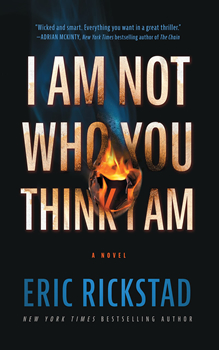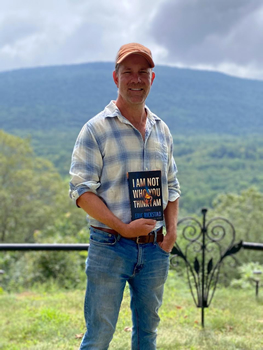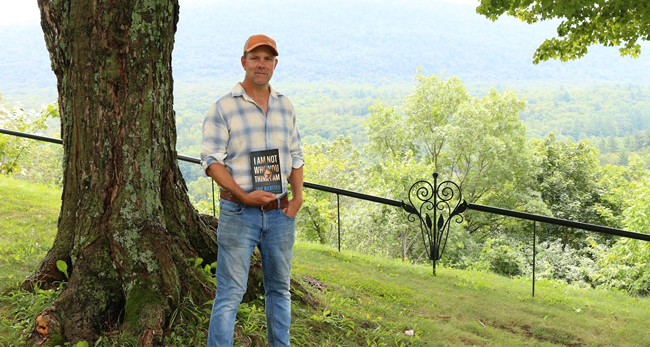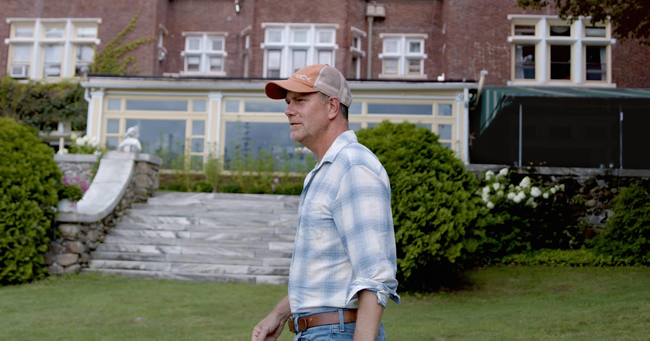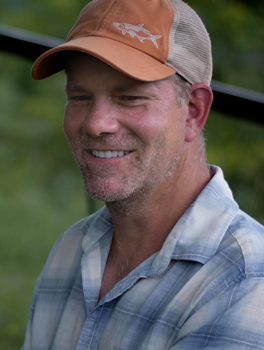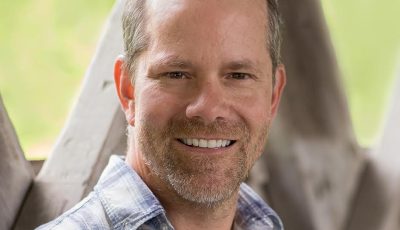

Up Close: Eric Rickstad
Earning the Dark
Wayland Maynard, the main character of Eric Rickstad’s I AM NOT WHO YOU THINK I AM, is only eight years old when he witnesses the unthinkable. Sent home early from school after eating too much cotton candy, Wayland enters his parents’ bedroom just in time to see his father prop a shotgun beneath his chin and pull the trigger. It’s through bloodied eyelashes that Wayland reads the note he finds on the floor: “I am not who you think I am.”
Eight years later, a deeply traumatized Wayland, now 16, becomes convinced that the man who shot himself to death on his parents’ bed wasn’t his father—after all, he never saw the man’s face. Wayland sets out to investigate the grisly death and cryptic suicide note, but his search for answers unearths long-buried secrets and triggers a chain of deadly events that will leave his hometown forever changed.
I AM NOT WHO YOU THINK I AM is a stunning achievement, equal parts searing family tragedy, gripping character study, and page-turning thriller. It’s not a supernatural story—though Rickstad is working on one of those, as you’ll learn in the interview below—but the ghost of gothic thrillers lurks around every sharp bend of the meticulously crafted, pitch-black plot.
In his latest interview with The Big Thrill, Rickstad pulls back the curtain on his writing process, delves into the tragic real-life events that inspired his new book, and offers a few details about his next novel and his current works in progress.
Can you give us some insight about what inspired I AM NOT WHO YOU THINK I AM?
I wanted to write a highly suspenseful, Gothic-tinged, but heartfelt psychological thriller that was a tragedy, full of mystery and wonder, libraries and books and words. Three things inspired this book.
When he is eight, the main character Wayland Maynard believes he sees his father end his own life. At his father’s feet he finds a note [reading] I AM NOT WHO YOU THINK I AM— Distraught and fearful, he hides the note and keeps it a secret from everyone. As a teenager, he begins to doubt everything about what he saw and what the note means. This triggers his investigation into what happened that day, and the unearthing of terrible secrets.
The first event that inspired the book was that I had a friend who experienced a similar trauma that was kept secret for decades, and led to a life of criminal behavior and his eventual death while being pursued by the police after an armed bank robbery he committed. No one outside his immediate family knew until after his death of the secret he’d harbored that traumatized him so much. The setup for this novel is fictionalized entirely, but it does ask: What happens to a young boy who witnesses such an event and never gets help for it?
There is also an estate in the town where I grew up, much like the one in the novel. Mansions and privacy, secrecy and privilege. When I was a child, both a barn and a house on the estate burned to the ground in the night. We lived close enough that my sisters and I walked out in the pitch dark in our pajamas to watch this massive barn burn, entirely consumed by raging orange flames. That image of fire in the black night, and the intense heat making us stand back, stuck with me. This image is at the end of the novel, as a mansion burning. I knew whatever trauma Wayland suffered would lead to this mansion burning. I just had to write the 250 pages between the beginning and the end.
Third, there are always books and authors that inspire, and for this one there were a few. Carlos Ruiz Zafón’s The Shadow of the Wind. I loved the Gothic feel of that novel, the young boy, the writing style, libraries and books. That inspired me.
I wanted to write a psychological thriller/tragedy, not just a thriller where, despite the trials the characters undergo, everything essentially “works out”—I was not interested in that this time around. So I sought out longtime favorite books such as Dennis Lehane’s Mystic River and Shutter Island. Both of these are tremendously dark but also very humane and empathetic toward their characters’ plight. You feel for the characters so strongly, and you desperately want things to work out, knowing it’s very unlikely they will. And even if things don’t resolve in a “happy” ending, they resolve in a satisfying ending, one that is earned, and, in the end, feels inevitable. Tragic. So I tried to write a book that had both the fateful sense of tragedy of books like Mystic River AND the psychological thriller elements of Shutter Island.
Shirley Jackson and Donna Tartt’s novels, the Gothic feel of them, the slow burn, the atmosphere and writing, were two others that inspired. They both lived and wrote their most famous books ten minutes from where I live. I drive by Jackson’s house regularly. Jackson wrote “The Lottery,” The Haunting of Hill House, Hangsaman and many others, and Tartt wrote The Secret History, which is set right in the area where I lived. So that combination of both their books and their living so close by kept me inspired.
Besides familiarity, what is it about rural and small-town Vermont that keeps you coming back to it as a setting for your novels?
Vermont creates a dramatic and compelling contrast between the beauty and serenity of the natural world, the state’s quiet, picturesque towns, and the danger that lurks in those woods and behind the doors of these homes. A beautiful river can turn life-threatening in a moment, a hike in the woods can go bad fast when the weather turns or a person gets lost. Mount Glastenbury, which I can see from my kitchen window, has been the site of many unsolved disappearances over the decades. A few years back, an elderly woman who was my neighbor was stabbed to death in her home one night. It was another neighbor of hers that did it. Someone she knew and trusted. Such events are a shock to the system, a great disturbance and divergence from what the eye sees as calm and lovely. There is high drama and tension in this contrast.
A novel is such a major undertaking; there’s the writing of it, of course, then you’re spending months and months revising, polishing, and then promoting it. How did you know this was the book you wanted to spend the next couple of years on?
I’d known for a long time, since that barn burning and learning of my own friend’s secret, that I wanted to write a book that wove those two events together. When I started writing it, and Wayland Maynard and his voice, his language, started to come out on the page, I knew I had it. It’s really his voice and language, his wanting to really tell this tale in retrospect as a man many decades removed from the events, that carries it and made it a joy to write.
Can you talk a little about how Wayland took shape for you?
Wayland, to me, is such a tragic character. He is a boy who is in way over his head in his pursuit of the truth. What he’s witnessed is so traumatizing, and he is left to deal with it and his thoughts and feelings about it almost entirely on his own. He is a lonely, sweet, smart kid, into his books by Poe and Jackson, loving to his dog, protective as he can be in his way of his younger sister who was also traumatized and struggling. He loves his mother dearly, but he fears after a while he cannot trust her to tell him the truth. She did something very odd just after he witnessed, or believes he witnessed, his father kill himself. She rid the house of every single item that ever belonged to his father, until there was no trace of his ever existing, except for the note, books, and .22 revolver that Wayland secretly kept. His voice, that original note at the very start of the novel, introducing himself—it had such a strong, singular tone to it, once it came, it carried the day. After that, it was Wayland’s book. I just had to try to do his story justice.
I understand you’re a pantser and that outlines don’t really work for you. Did that hold true for a book as meticulously plotted as I AM NOT WHO YOU THINK I AM?
It held true. I follow my characters around and see what happens to them. It’s been said, perhaps first by Stephen King, perhaps not, that writing is like an archeologist digging to unearth an object, and for me that works as an analogy. I dig and pick around, and at first, I am using the bigger tools, the shovels and axes, finding the rough edges, the general shape of the thing. As I get further along in editing and creating the tension and all the little events that become profound at the end, the reveals and character nuances, I begin to polish and use finer tools until I’m down to a feather brush, so to speak. So much is discovery for me. That’s the challenge and the joy of it for me. For instance, the note “I am not who you think I am,” which of course is the entire lynchpin of the book, was a note Wayland found when he witnessed his father do what he did. I had no idea there would be a note until Wayland looked down and saw it. I had no idea what the note would say until he turned it over and read it. And I had no idea what it would mean until he started to investigate it. If I sat down and tried to outline this book, none of that happens. None of it. I know this for certain. This book never gets written the way it does, the way it was meant to be. As David Lynch says, “Trust your subconscious.” That’s where the best stuff is, for me anyway.
Were there any other books, movies, or songs that were knocking around in your head while you were writing this one?
Well, the two Lehane novels in general, Mystic River and Shutter Island. Mystic River for its sweeping tragedy, of innocence lost as a kid, and what to do with that as an adult. The idea that this was going to be a tragedy and to dare to do that but do it with empathy and humanity. This isn’t, for me, just a “thriller.” It’s a tragedy, a character study. For the psychological part, I loved what Shutter Island did. You’re not even aware at first that things are off, something is not right, not real, and then as you become aware, it becomes highly suspenseful and fraught with mystery and emotional with its human cost. Plenty of songs too. I listened to the “darker” and more melancholy of Springsteen’s songs. Stuff from Darkness on the Edge of Town and Nebraska, songs that have a lot of tragedy and romance and loneliness in them. I also listened to a lot of Lera Lynn’s more melancholy songs. For movies, I was into classics that involve mansions and Gothic elements, like The Innocents, based on The Turn of the Screw, Rebecca, and the original The Haunting, based on The Haunting of Hill House.
Tell me a little about your writing process. I understand you handwrite your first drafts, often in the woods and presumably while fighting woodchucks for your pencil?
The woodchucks stand no chance against my pencil, or the knife I use to sharpen it. I do write most of my rough drafts in notebooks with a pencil. I like to be outside, so it allows that. There is also the physicality of the pencil I prefer to a keyboard. I like to scratch and cross out sentences, make arrows and notes. I like to tap the pencil when stuck, or to doodle. It also takes me away from social media and all the distracting nonsense of the Internet. When I get a ways in, I’ll start to type it into the Word doc. By that point, going from notebook to Word, it’s a third draft because I’ve edited in my head from notebook to Word.
You’re a master of plot twists and truly stunning reveals. What’s the secret to crafting a plot twist that surprises but still plays fair?
First, that’s very kind of you to state. I work hard at it. I think part of my success at it is because I don’t usually know any more from the outset of a book than the characters do. In the case of I AM NOT WHO YOU THINK I AM, I know a mansion will burn at the end, but not why. It is as much a mystery to me as it is to the reader. And I think that sense of mystery comes through, that creeping, suspenseful sense of not knowing where to find footing. But I am always, always aware that the reveals and twist must be anchored in the reality of what’s taken place earlier. I trust the subconscious enough to know by now that the answers will come because they are already there, waiting for me.
But I don’t have any taste for novels or films that don’t play fair, with just one sole twist that feels forced or contrived or makes the entire plot all about that one twist. And by playing fair, that also means that I won’t force a novel to be more hopeful or upbeat if that’s not what is required, no more than I will force an ending to be “darker” or more “twisted” for shock value when that is not in order. I don’t consider that “dark.” I consider it as honest, and having the respect and faith in readers that they don’t need or deserve an ending that is forced to be “happy.” Those books don’t appeal to me. My endings and reveals are all about staying true to what it’s earned. As far as the mechanics, or craft, or secret? I don’t know, honestly, and I don’t want to know. Call me suspicious, but I fear if I ever truly figure that out, some of the magic will be gone.
Can you say anything about what’s next for you?
I finished a book about an FBI agent investigating the bizarre and seemingly disconnected murders of families across the country. It’s Mindhunter of modern day, turned on its head and inside out. It’s unlike any other “serial killer” novel that I’ve ever read, and hopefully the reader as well.
I also wrote a collection of short stories I love. And I’m at work on a novel about a woman who has had enough, and a “haunted house” story set in 2039.
- Between the Lines: Rita Mae Brown - March 31, 2023
- Between the Lines: Stephen Graham Jones - January 31, 2023
- Between the Lines: Grady Hendrix - December 30, 2022

